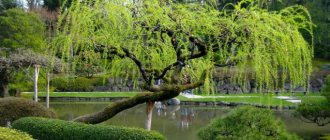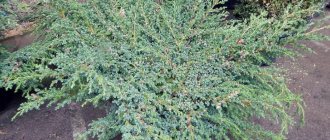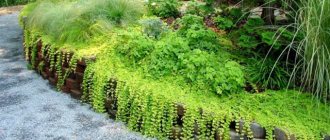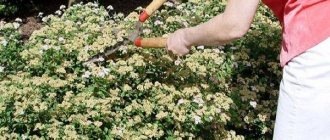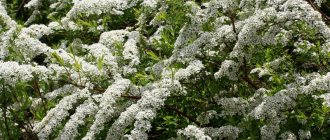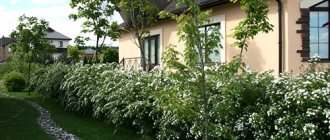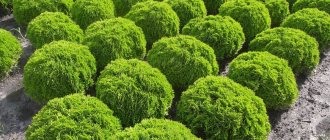Landing
Little Princess is not a demanding crop, but prefers fertile, loose, moist soils with good drainage. Loamy, neutral or slightly acidic soils are suitable.
Selection and preparation of a site
The bush develops worse and does not bloom profusely if you choose a heavily shaded area with depleted soil. Moderately tolerates drought, adapts well to urban gas pollution. It is advisable that the plantings be protected from drafts by outbuildings, fences, and other shrubs, especially in regions with harsh winters.
For planting, choose an area that receives sunlight for at least 4 hours a day. The pit is prepared in advance, two days in advance. For cover plantings, a frequency of 6 plants per 1 square meter is allowed. m. Seedlings are purchased in the spring, before the leaves bloom, in April. In a cool room they can be stored for several days without compromising quality.
Saplings
They buy plants that are strong, without traces of parasites and rot, diseased and dry shoots. The exposed root system is carefully inspected, roots that are too long and damaged are removed. The roots are soaked in water for several hours, the containers are placed entirely in the liquid, and care is taken not to damage the earthen ball.
Long shoots are trimmed and the exposed root system is sprayed with a root formation stimulator. The shrub is very tenacious, so do not despair, even if you come across a seedling with a dried out earthen lump. In this case, before the planting procedure itself, several small vertical cuts are made on the roots, this causes their increased growth.
Landing
The holes are dug in such a size that the rhizome fits freely. In wet soils, a drainage layer is placed at the bottom of the hole. The removed turf is mixed with peat and sand 2:1.
- The soil is poured into the hole with a mound to cover 1/3 of its volume.
- The seedling is placed on top, the roots are carefully straightened.
- Cover with soil without deepening the root collar.
- Compact the soil.
- Water with warm water.
An unpretentious culture is extremely simple to maintain. Timely watering and pruning, disease prevention are the main requirements for abundant flowering and good development of spirea.
Top dressing
If you add organic matter to the soil when planting, the plant does not need feeding in the first year of its life. In the future, it is enough to add nitrogen fertilizer to the soil near the bushes in early spring, and compost in the fall. The shrub responds well to fertilization with mullein infusion (1 part manure to 1 part water, kept for 7-10 days). Add 10 g of superphosphate to 10 liters of solution (1:10) and pour it under the root.
Watering
The plant's shallow root system suffers during hot and dry seasons. At this time, water more often, weekly. In normal weather, 2 times a month 15 liters of water per bush is enough. On hot days, irrigation will help the spirea to bloom profusely and not lose its decorative appearance.
Loosening
The soil is loosened after watering and rain, when the surface becomes crusty. The digging depth is small - 5-6 cm. The tree trunk space is mulched with a layer of peat up to 7 cm high. In the warm season, weeds and debris are removed.
Diseases
Spiraea Japanese Little Princess is practically not susceptible to disease. The appearance of the bush will be spoiled by an attack by pests, which are most often active in hot, dry weather.
- The leaf roller damages young leaves in late spring.
- Aphids suck juices from young shoots.
- Spider mite - entwines the plant with a web, causing branches to dry out and die.
Systemic treatments with folk remedies and chemicals prevent parasite attacks.
- karbofos, solution 0.3%;
- phosphamide – 0.2%;
- acrex – 0.2%;
- pyrimor – 0.1%;
- tobacco infusion - 50 g of dry leaves, pour 1 liter of boiling water, leave for 3 days;
- soap solution - 25 g of laundry soap per 1 liter of water, add a few drops of kerosene.
Pruning, preparing for winter
Annual spring pruning stimulates the growth of young shoots and the splendor of flowering. The branches are shortened, leaving 15-20 cm above the ground. Remove dry and damaged shoots.
Summer formation of the bush involves pruning every month. The plant looks great even without flowers - the bottom of the trunks is not exposed, the dense crown of different shades gives the landscape a unique look. On varieties with yellow foliage, reverse shoots with green leaves are completely removed.
The frost-resistant variety does not require shelter for the winter. Only in northern regions with severe cold do they cover the base of the bush with straw, wrap it in cloth, and cover it with spruce branches to a height of 15-20 cm. In the first year of life, the seedling is protected from frost with covering material, and a wooden box is placed on top. Frozen shoots are pruned in the spring; they are easily restored and do not affect the appearance or decorative effect.
Growing methods
There are several ways to plant little.
- Bush planting. The Little Princess bush can be purchased at a specialty store that sells plants for gardening. By the way, the price for them is quite reasonable. Then you need to prepare a hole in a pre-selected place. Having generously moistened the roots and the bottom of the hole, lower the bush and sprinkle it.
- Planting by cuttings. According to gardeners, planting from cuttings gives good results. Its essence lies in the fact that a cutting cut from a young shoot is planted. The length of the cutting must be at least a decimeter.
- Planting by layering. This type of planting is the most favorite among gardeners. You need to start it in the spring, when the princess begins to bloom leaves. You need to place several branches in the furrows prepared in advance. To prevent them from rising, you need to fix them with something. Then, sprinkle the branches with soil and water them abundantly.
If everything is done correctly, then soon you will be pleased with its beauty by a flowering bush of Japanese spirea. This plant is very unpretentious , so when creating the necessary conditions for growth, you will not have to take special measures.
What Japanese spirea needs for good growth:
- Condition of the soil cover. Little Princess grows literally everywhere, the condition of the soil does not play a big role. The only thing that needs to be done is to feed the plant once a year.
- Watering conditions. Spiraea requires heavy watering only at the time of germination. In the future, there is no need to make special efforts in watering, only in the dry season.
- Winter period. With the onset of cold weather, the princess bush should be sprinkled with dry leaves. In the spring, the bush needs to be inspected by removing diseased branches.
Caring for Japanese spirea little princess
Spiraea little princesses, like any ornamental plant, requires care. Since this plant is considered outdoor and sun-loving, you should try to plant it on the sunny side.
But in principle, these bushes grow well on the shady side. In order for the plant to grow better, it must be fed with Kemira Universal fertilizer . Fertilizing should be done at the rate of 100 grams per square meter.
When caring for shrubs, you don’t need to get too carried away with watering. If the season is dry, then it will be enough to pour ten liters of water onto the bush twice a month . True, very young plantings require more abundant watering. When caring for recent plantings, be sure to loosen the soil more often and remove weeds, especially after watering.
Reproduction, transplantation
The shrub reproduces well and quickly, adult plants provide planting material in abundance, so gardeners often do without purchasing seedlings. Replanting an unpretentious plant is possible throughout the spring-summer period, the main thing is not to damage the root system when digging and quickly move it to a new place, trying to preserve the earthen ball on the roots as much as possible.
Seeds
This propagation option is good if you need to get many single-variety plants at once. It is taken into account that varietal characteristics are not transmitted to the entire generation, but only 40%. This method requires not cutting off the dried inflorescences, but leaving them on the branches until they ripen. The fruits are harvested at the end of summer or autumn and stored for ripening. Unopened but brown fruits retain more seeds.
Sowed in October, November. Use a container with fertile, light, loose soil and dig it into the garden bed. The seeds germinate in the spring and are harvested in early summer when the sprouts reach 2 cm in height. At the same time, the seedlings are sorted according to varietal characteristics, since at this moment a difference in the color of the leaves already appears. The roots are pinched and the plants are planted in boxes at a distance of 5-6 cm from each other.
Cuttings
Planting material is taken in July or September - October. Autumn cuttings are covered with fallen leaves and covered with vegetable boxes for the winter. In spring, plants take root; they require special care during the cold season. Summer cuttings are kept in greenhouse conditions until roots appear.
- Choose a strong, straight shoot.
- Cut into pieces, each of which has 4-5 buds.
- The leaves below are removed, the top ones are shortened.
- Place in water for several hours.
- The ends of the petioles are dipped in a powdered root former (Root, Kornevin).
- Planted at a depth of 2 cm in a container with wet sand at an angle of 30-45°.
- Cover with film or cut-off transparent plastic bottles.
- Maintain air humidity by constant spraying and ventilate daily.
Division
The method is suitable for young but well-developed plants. The bush is dug up, trying not to damage the root system; it is washed off the ground under running water to see the location of the roots and shoots.
- The most developed sections of the rhizome are determined in order to obtain uniformly strong parts.
- Cut the bush with pruning shears, obtain several young plants with approximately the same number of buds and roots, each with at least 2-3 shoots.
- The holes are made with a garden drill if you need a lot of them.
- Cut off the long roots, straighten the remaining ones neatly on a mound of soil poured onto the bottom of the hole.
- The holes are filled in, the top layer is compacted, mulched, and watered.
Spiraea japonica Little Princess is a hardy variety that even an inexperienced gardener can grow.
11. Interesting facts
The name "spirea" in Latin means "spiral", and comes from the thin, elastic branches of the bush. In Greek, the word "speira" means "bend" - and indeed, the branches of various species are often arched.
Spring-flowering plants have another name - “white bride”, as they form long, drooping inflorescences with white buds, and from a distance the bushes resemble a girl in a wedding dress.
When choosing a species, it is worth considering that some plants easily propagate by self-sowing and fill any free space in the garden.
The green parts of plants and shoots contain ascorbic acid, carotene, and spirea is sometimes used in folk medicine as a medicinal plant.
You might also be interested in:
Spiraea goldflame, varieties of Japanese spirea, propagation of spirea goldflame flame
Spiraea goldflame is a perennial shrub from the Rosaceae family. The color, size, and shape of the leaves depend on the variety.
In general, the height varies from half a meter to two meters. Depending on the branches, the Japanese goldflame spirea bush can be either round, cascading, pyramidal, or simply spread along the ground.
Flowering in some varieties of spirea goldflame begins in early May, in others - in mid-summer. Buds in the form of umbrellas. So, by planting different varieties in your garden and combining them wisely, you can get an interesting composition.
Varieties of Japanese spirea goldflame
Spring varieties
- Oak leaf - the bush is huge, up to 2 meters high. The stems are drooping, the leaves are ovoid, pointed at the end, rich green in color, blooms from mid-May. The flowers are white and fall down, reminiscent of a bride's veil. Therefore, this variety is popularly called “bride”.
- Spiraea Arguta - the branches are strong, reach two meters in length, stick out in different directions, slightly drooping. The leaves are dense and medium in size. During flowering, the white flowers of Japanese goldflame spirea are so dense that branches and leaves are not visible.
- Nipponskaya is a low-growing spherical shrub about a meter high. Small leaves sparsely cover the perimeter of the stem. The inflorescences are white and dense.
Summer varieties
It should be noted that not all summer-blooming varieties smell.
- Spiraea golden is a bush in the shape of a ball and up to 80 centimeters high. The oval, oblong shape of the leaves with teeth at the end gives the bush a special decorative appearance. The color of the leaves during flowering is bright green, the rest of the time they are reddish-orange or yellow. It begins to bloom in July and ends in autumn. The petals are pink, collected in corymbose inflorescences.
- White-flowered - unlike other varieties, it thins out the pleasant smell. Height up to 60 cm, bright green leaves, white flowers.
- Spiraea Bumalda is a hybrid variety. The bush is up to 120 cm high, the leaves are oval, concave along the main central vein. The flowers are pink. The variety is not resistant to frost and needs insulation.
- Willow is a tall variety with a height of 2 meters. The shoots are straight, the leaves are similar to willow, changing color from green to red. The flowers are pink in color and consist of five petals and stamens protruding from them.
Landing. Care
The plant is unpretentious. A novice gardener can easily grow Japanese spirea
Pay attention to the roots of the seedlings. They shouldn't be dry
How to understand that the roots of seedlings are not overdried? The shoots and buds will tell you about this. They must be well developed and flexible.
The site for planting should be chosen as sunny, because Japanese spirea is a light-loving plant. The soil must be fertile, loose, moist, and have a drainage layer. Planting should be done in wet weather.
Having dug a planting hole, place the plant in it, sprinkle it with soil up to the root collar and water it.
The color of the leaves depends on the soil. On acidic soil it is purple, in the shade it is rich green. Young bushes need to be protected from drought and freezing. Adult Japanese spirea tolerates both cold and drought well.
It should be borne in mind that a young plant will definitely grow, so select a larger area. Watering Japanese spirea during drought is enough a couple of times a month. After watering, weed and loosen the soil.
Use peat, compost, and crushed tree bark to mulch. During the season, fertilizing with mineral and organic fertilizers is carried out 3-4 times.
Preparing for winter
Only the young bush needs to be protected from the cold. An adult plant is resistant to frost. Even minor damage to the Japanese spirea is not dangerous. The bush recovers quickly. How to prepare a plant for winter? The soil is loosened. The branches are tied and dry leaves are placed under them. Then they bend it to the ground and secure it in this position with metal brackets. Then it is covered with insulation.
Preparing for winter
Adult plants are quite hardy and do not require shelter for the winter. Minor frost damage to the spirea is not dangerous, since it recovers very quickly due to the formation of new shoots. But the young bush must be protected from the cold, especially in the first year of life.
Before the onset of the first frost, the soil around the plant needs to be thoroughly loosened by pouring a 20 cm high mound of garden soil into the center. Decomposed compost or peat can be used to mulch the tree trunk circle.
Snow can also perform this function if it falls in sufficient quantities.
Formation of bushes
Immediately after planting, the soil near the plant should be sprinkled with a protective peat layer. One of the types of care is trimming bushes. These plants tolerate it very well.
On the other hand, cutting must be done carefully , taking into account the type and age of the shoots. Spiraea are divided into two types, depending on the formation of the buds. If the buds are located along the entire length of the shoot, then it cannot be pruned annually.
When pruning, it is necessary to remove shoots that are between 7 and 15 years old , as well as their frozen tips. Heavy pruning is carried out when bushes are rejuvenated. In such cases, the bush is trimmed completely, leaving only the stump.
As a result, rapid growth of juveniles from the buds located near the rhizome. Then 5-6 strong shoots are left from the young growth, and the rest is cut off. A new bush is formed from the remaining shoots. In order for the early-flowering spirea bush to form correctly, pruning should be done in early spring.
Unlike early-flowering species, late-flowering species of these plants have inflorescences formed at the ends of the shoot. Therefore, they must be pruned every spring . The strongest bud on the shoot is determined and the rest is cut off to it.
Small and old shoots are also . After a certain time, the bushes are also completely pruned at the root. It is worth noting that early flowering plants are more durable than late flowering ones.
Pest Control
One of the methods of care is to combat various kinds of pests and diseases that cause damage to these plants. Unfortunately, there are many pests that love spirea. In order for the plant to develop properly, it is necessary to immediately combat these pests and diseases.
Spider mites are considered one of the dangerous pests . Its appearance can be determined by the presence of cobwebs, early yellowing of the foliage, holes in the inflorescences and foliage, as well as the general sickly appearance of the plant.
As soon as you see such signs on the bushes, you need to immediately take action. To combat ticks, spraying with a solution of phosphamide or karbofos . Methods for preparing solutions can be read directly on the preparations used.
, aphids are a common . Aphids destroy inflorescences by sucking the juice from them. When fighting aphids, pyrimor, rose leaf roller and miner are used. It is advisable to combine chemical control agents with natural ones.
Planting and caring for spirea Little Princess
The plant itself is quite unpretentious, so caring for it is easy. Perennials, with rare exceptions, are quite tenacious plants. To bring them not only to death, but even to a bad appearance, you should seriously “try.”
However, even when growing them, one should not forget about the basic features of caring for bushes of this type, especially those with dense foliage.
This should not be done, since such actions will lead to a significant increase in a large amount of green mass, and the first flowering may not occur in the third year, but much later.
Next, the issues of planting and caring for the Japanese Little Princess spirea are discussed in more detail.
Preparation of planting material and site
Little Princess spirea is planted in the spring, starting in mid-April or early May. The selection of seedlings is made according to the following method: it is necessary to take only those specimens that have a bare stem with buds, preferably without leaves. The roots of the seedlings should be moist, without rot or dried areas. Good quality seedlings have noticeable flexibility.
Preliminary preparation of seedlings consists of shortening too long roots and removing the ends of shoots located above 3-4 cm relative to the last bud on them. Immediately before planting, the seedlings are soaked in liquid for a day and then washed with running water.
A sunny site for spirea is preferable, but this is not critical. The plant tolerates partial shade well. The root system is located close to the surface, so the groundwater level at the planting site is not critical.
The soil on the site can be anything, even slightly rocky, but Japanese spirea Little Princess grows best in moist and loose soils of weak acidity. The ideal soil is the so-called “leaf soil”.
Planting spirea Little Princess
To plant the plant, dig a hole with steep walls. The volume of the hole should be approximately 3-4 times greater than the volume limited by the root system. The hole must be dug 2-3 days before planting and it must simply “stand” open all this time.
Drainage is laid at its bottom in one layer of broken brick or expanded clay. The soil for planting can be used as follows:
- 4 parts leaf soil;
- 1 part peat;
- 1 part river sand.
Planting is done on a cloudy or rainy day, with the plant placed in a hole and sprinkled to the level of the root collar. After which the soil is compacted and watered abundantly.
Planting is completed by mulching the soil to a diameter of 30 cm from the center of the bush using peat.
Watering and fertilizing
The plant needs abundant watering only during transplantation and in the first years of life. Plants older than 2-3 years only need to lightly moisten the soil once a week. Naturally, during periods of drought, watering should be more abundant.
The root system, located close to the soil surface, can quickly begin to rot with heavy watering.
Feeding is done 2 times per season. The first is carried out after spring sanitary pruning; it includes mineral fertilizers, standard for ornamental perennials.
The second is done during the flowering period; it includes the use of organic fertilizers (for example, mullein in a concentration of 1 to 10).
Pruning spirea Little Princess in autumn
Caring for the Little Princess spirea involves pruning it, usually done at the beginning of the season. This is a standard procedure consisting of sanitary pruning and removal of too old shoots that interfere with the active growth of the bush.
In autumn, only pruning of the plant’s fruits is done, since they spoil its appearance and take away additional resources from it. This pruning is carried out in July-September as the fruits appear.
More mature bushes, older than 10-15 years, are recommended to be pruned every 4-5 years to a height of 20-50 cm relative to the soil level. In this case, 3-4 buds should be left on them. If after such a procedure the bush does not grow abundantly within 1-2 seasons, it is replaced.
Preparing for winter
In temperate climates, Little Princess spirea does not need to be prepared for winter. If harsh winters are ahead, it is enough to cover the bushes in the fall with a thick (up to 30-50 cm) layer of fallen leaves.
How to properly care?
Shrub care begins with timely watering. In the first years of life, the plant really needs a sufficient amount of moisture. After the first flowering, you can water once or twice a week; if the summer is dry, the number of waterings can be increased. You cannot flood the shrub, as the roots are located too close to the surface and can rot, which will lead to the death of the plant.
You can feed "Little Princess" twice a season - first after wintering, then during flowering.
After wintering, when pruning is done, you can fertilize the soil with a complex of minerals, and during the flowering period - with mullein or bird droppings.
You need to regularly loosen the soil and prevent the formation of a crust around the roots. Loosening should be done shallowly so as not to damage the roots (no more than 5 cm), always after rainfall or watering.
Planting and proper care
In order for the Golden Carpet spirea to become a high-quality plant with beautiful forms, it must be grown correctly. Moreover, you need to start from the moment of disembarkation.
Soil for planting
This unpretentious shrub can grow on all types of garden soil. It shows its best qualities on well-loosened nutrient soils, where there is drainage or there is no possibility of water stagnation.
Before planting, 1–2 kg of organic fertilizers are added to the soil, after which it is dug up using a shovel.
Reproduction
Each summer resident or gardener chooses how to propagate spirea. This plant is quite resistant to all the “hardships of life”, so it can take root even with the simplest methods of propagation.
Familiarize yourself with the propagation of spirea by dividing the bush.
The following types of propagation are commonly used:
- cuttings;
- layering;
- seedlings.
Before planting the seedling, prepare a hole of sufficient depth to straighten the roots and submerge the root zone by 1–2 cm. A small drainage is made from vermiculite. The bush is covered with earth, watered, and the root soil is compacted. Other methods are also simple, but you still have to perform some operations.
By cuttings
Propagation by cuttings is the most promising, since a ready-made branch is taken.
Important! The container with cuttings must have drainage holes to remove excess moisture.
The description of cuttings is as follows:
- Prepare a container with soil; you can mix it with perlite.
- Pinch off a green branch from the parent plant.
- Remove all lower leaves, trim the top with pruners or scissors, leaving a piece of stem with 3-4 leaves.
- Stick the cutting into soft soil up to the bottom leaf.
- You can plant 4-5 cuttings in one container, after which you need to cover them with a plastic glass or transparent film and put them in the shade.
- After a few weeks, the cuttings will take root and can be transplanted into open ground.
By layering
After the snow melts, you can try to propagate Japanese spirea by layering. For this, root sprouts or lower branches are used.
Find out also how to grow spirea in Siberia.
Reproduction by layering is carried out as follows:
- You need to make a small groove near the root or shoot selected for removal.
- Bend the root shoot or branch of the plant into this groove and strengthen it with a hairpin, slingshot or other suitable device. Then cover the trench with soil.
- Next, you need to decide what type of seedlings you need to get. If you need one powerful one, then do not pinch the top of the sprout. If you need several, then after pinching the top, a new sprout will grow from each bud.
- In the fall, the cuttings are dug up and divided according to the number of shoots - the seed is ready.
Fertilizers
You can fertilize the plant with a standard mixture for garden shrubs in accordance with the manufacturer's instructions. This is done 1-2 times a year: in the spring and after flowering in the autumn. It is possible to fertilize with a small amount of organic fertilizers in the root zone.
Did you know? The Russian name for spirea is meadowsweet. But this is not entirely correct, since meadowsweet are herbaceous plants, and spirea are shrubs.
Plant pruning
The small dimensions of the bush make it easy to give it a wide variety of shapes: round, cubic, pyramidal, cone-shaped. It all depends on the wishes and imagination of the owner of the site. An interesting design is in the form of a stream along a slope or a rectangular border along a park alley.
During the first two years of life, the bushes should not be disturbed by formative pruning. At this age, you only need to remove dry inflorescences, as well as diseased and broken branches. From the third year you can begin to form the crown. Every three years, old branches are removed and cut off near the ground.
Watering and humidity
Spiraea loves moisture, but its excess can have a detrimental effect, therefore, in addition to organizing drainage before planting, it is necessary to ensure that water does not stagnate around the bush. After planting, it is useful to build a roller of soil around the plant where watering will be carried out. After the first watering, the root zone within the boundaries of the roller is mulched with dry leaves, sawdust or wood chips.
You need to water as the soil dries out - if the soil near the trunk of the bush has dried out by 1-2 cm, it is necessary to water it. After heavy rains, you need to ensure that excess water does not accumulate under the plant, but is drained away from it.
Biological characteristics of the plant
Spiraea shrub Gold Little
Princess spirea is characterized by hardiness, survives under any conditions, the plant is grown throughout the country: from the Arctic to the southern borders. Some varieties (the total number of which is 90) may freeze slightly in harsh years, but quickly recover after sanitary treatment; princess spirea blooms in the same year. Golden spirea requires only 3-4 hours a day to grow and bloom; better appearance is achieved with more sunny days.
Spiraea Gold Little Princess is quite unpretentious; fertile soil, fertilizing, watering, and shelter for the winter are not required. There is no need for pruning, which can be used to give the plant an attractive appearance. The height of the bush can vary depending on the variety within the range of 20-25 cm - 1.5 m. The crown is hemispherical, in some varieties it is dense and dense, in others it is “disheveled”, but always neat-looking and well-leafed. Flowering occurs in July-August, seeds ripen in October. When blooming, the leaves acquire a characteristic reddish-brown hue, after which they turn green, and in the fall they again become reddish and golden. The flowers have a pinkish tint and the plant is an excellent material for pruning.
When to prune Little Princess spirea
Pruning is needed to give the bush a beautiful shape. This procedure must be carried out until inflorescences and buds appear on the plant. The best time is spring; at this time there will be sanitary pruning of damaged branches after winter. All frozen and broken branches are cut to the ground.
Full pruning is carried out when the Little Princess spirea bush reaches 4 years of age. In this case, all branches are cut to a length of 15-20 cm. If the shoot is weak and thin, it is removed completely.
If with this method of pruning the plant grows even weaker, this is a reason to dig it up and replace it with a new one.
The uniqueness of Japanese spirea varieties
Japanese spirea is a plant of absolutely incredible beauty and grace. The height of this species of meadowsweet varies depending on the variety. But we must admit, the “Japanese” is never tall and does not reach 1.5 m, like other varieties, such as gray spirea, loosestrife, arguta, etc.
At the youth stage, meadowsweet shoots are covered with a hard edge, similar to felt. But the old branches lack such coverage. The stems are directed upwards. The leaves grow densely and are shaped like an elongated egg. In summer, the foliage most often has two colors: the bottom is gray, and the top is soft emerald. But in the fall they merge and become yellow or red. Rich lush inflorescences of spirea are collected from small flowers.
- Little princesses. The bush of this variety of spirea does not differ at all in growth. The maximum that the trunk of a “little princess” can reach is 60 cm. But its crown is very good and neat, in shape it resembles a fairly regular oval, with a diameter of up to 120 cm. The Little Princess successfully combines emerald leaves and red-pink inflorescences.
- Golden princesses.
This variety is the closest relative of Little Princess. But they have 2 significant differences. The first is the height, which in the “golden princess” easily reaches 1 m. The second and main difference is the golden-yellow leaves of the bush. Golden Princess variety - Goldflame is another spirea with yellow leaves. But here, despite the name, they do not have a golden, but an orange hue. And the height of the stem barely reaches 80 cm.
- Crispa. This low bush grows up to 50 cm, and its diameter is only a few centimeters larger. The crown is shaped like a ball. The inflorescences are an almost fabulous pale pink color, shaped like umbrellas.
- Shirobana. The shrub of this variety of Japanese meadowsweet has a standard height for this species - 80 cm and a crown with a diameter of 120 cm. The foliage is small and dark green, and the flowers are pink or snow-white.
Crispa variety
Application in landscape
With proper care, spirea can decorate any corner of your garden. Gardeners actively use this.
- If the flowerbed looks too lonely, you can plant Spiraea in the center. Due to the rounded shape, it looks harmonious and helps the color scheme look more advantageous;
- Due to its short height, the plant is convenient to use as a border. So, you can plant Spirea Little Princesses along the fence, around the gazebo, house or pool;
- When growing Spirea in a spacious pot in a front garden, you can control the flowering period. Sufficiently skilled gardeners can achieve this even in winter;
- This plant gives an unusual combination with lavender, barberry, conifers and St. John's wort. When planting, do not forget to take into account that although Spirea can get along with its neighbors, it is still undesirable to plant it in the shade of other plants;
- If you are eager to highlight the pink color of Spiraea inflorescences, then shrubs with poorer flowering. The main thing is that the flowering periods of the selected plants coincide.


